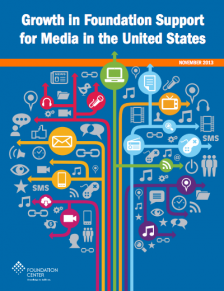Data, collaboration help lift 'fog of war' in news media grant making

Four years ago, when I left my job as a newspaper editor and began working with a foundation interested in making strategic investments in journalism, I started with a blank slate.
Not only had The Patterson Foundation given me tremendous latitude in determining where we should focus our energies and funding, I didn't have much line of sight into how other foundations were approaching support for journalism.
I heard this refrain over and over in the interviews I conducted to help me map a course forward, both from funders and from those working across the field itself:
"It is impossible to see clearly exactly what is getting funding, and it is impossible to figure out where there is momentum that could benefit from more shoulders to the wheel. The result: duplication of effort existed alongside monumental gaps, with the potential for everyone to make the same mistakes over and over."
That's what excites me about a recent report on grantmaking in media. While the title may not be poetry -- Growth in Foundation Support for Media in the United States -- the report itself is full of information that is both inspiring and insightful.
Others much closer to the foundation world than I am already have commented on both the inspiration and the insight, particularly in posts by Eric Newton of the Knight Foundation and Steve Waldman, lead author of the FCC report Information Needs of Communities: the Changing Media Landscape in a Broadband Age.
The report speaks to my experience both as a representative of a funder and someone whose work has itself been funded by grants. It appeals to the data geek in me and to my conviction that the only way to approach the future of journalism innovation is through collaboration.
The report itself is a healthy example of collaboration -- the effort of eight foundations, the Pew Research Center, the Foundation Center, GuideStar and the network of Media Impact Funders.
I take heart in that fact, and to what I've seen as a growing willingness among foundations to collaborate in more than just name only. As the representative of a short-term player in media funding, I knew all along that the only way our work -- projects like business mentoring for indpendent publishers -- would have legs was if it connected into the work of long-term media funders.
We were able to make some key connections to keep our best work moving forward beyond our funding commitment. But making those connections, I have to confess, was a time-consuming and often frustrating process. It was a process that, as an outsider to the foundation world, I did not navigate very well.
Based solely on my own experience, I'd offer a bit of advice when it comes to one of the takeaways from the report: the need to expand the number of players funding into media and journalism. I would urge the major funders to think about more than just a recruitment process for attracting new foundations into the arena, but to focus as well on more intentional networking, sharing best practices, partnering and even mentoring of funders who are new to journalism.
The geek in me has been thrilled by the data that accompanies the report, and the excellent presentation of that material at the Media Impact Funders website. This is the beginning of real understanding about where foundation dollars are going across a range of factors -- by type of journalism, by platform, by geography, by institution, by business model.
I wish this had been around when I was starting my work four years ago. The data, if it is used, will help funders lift some of the "fog of war" that I heard about in my initial interviews, letting us see into the gaps and understand with more than our guts where investments can and should be made.
In my experience, both funders and those seeking funding operate with a certain naivete about each other. Funders see ahead to outcomes they want to enable, and sometimes lack real understanding of the iterative process it can take to get there. And those seeking funding miss the bigger picture of existing foundation commitment, limitations and, yes, politics among foundation staff and boards that can help determine what gets funded and what doesn't.
The more that we can use the data to see what is actually happening, the better our conversation can be about what needs to be happening. And that is a powerful step forward.



